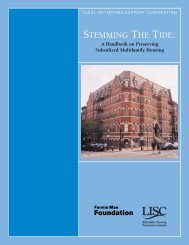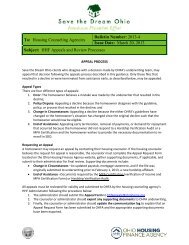OHFA Annual Plan - Ohio Housing Finance Agency
OHFA Annual Plan - Ohio Housing Finance Agency
OHFA Annual Plan - Ohio Housing Finance Agency
Create successful ePaper yourself
Turn your PDF publications into a flip-book with our unique Google optimized e-Paper software.
Workgroup #7:Vacant <strong>Housing</strong>Workgroup members: Don Lenz (Greater Cincinnati Redevelopment Partnership, Inc.), JoelOwens (Community Building Partnership of Stark County), Amy Riegel (City of Dayton),Frank Ford (Neighborhood Progress, Inc.), Doug Harsany (OHCP), Marvin Hayes (Governor’sOffice), Dana Kozak (US Bank), Sharon Francis (MiraCit Development Corp.), Patricia Barnes(<strong>Ohio</strong> CDC Association), Karen Banyai and Matt Wootton (<strong>OHFA</strong>).Meeting history: 8/1, 8/13, 9/4, 9/22, 10/2, 10/9, 10/30<strong>Housing</strong> Need Description and its Urgency to <strong>Ohio</strong>A 2007 study of vacant properties in eight <strong>Ohio</strong> cities by ReBuild <strong>Ohio</strong> and CommunityResearch Partners identified more than 15,000 vacant and abandoned buildings. Most ofthese properties were residential since few cities have systems for tracking numbers ofvacant commercial and industrial properties. The study defined a “vacant property” as “…achronically vacant and uninhabitable property for which the owner is taking no active stepsto return the property to the market.” (p. iii, $60 Million and Counting: The cost of vacantand abandoned properties to eight <strong>Ohio</strong> cities).Data from the US Post Office (http://www.huduser.org/DATASETS/usps.html) shows astatewide total of 212,419 vacant residential properties in <strong>Ohio</strong> as of September 30, 2008using a definition of houses where mail has not been collected for three months.The ReBuild <strong>Ohio</strong> study points to a number of factors for the vacant property crisis, includingjob and population losses, an older housing stock, foreclosures and subprime lending, andproperty tax delinquencies in <strong>Ohio</strong>. Foreclosures in particular are widely seen as a majordriver of the large numbers of vacant homes in <strong>Ohio</strong>. Allan Mallach, in a report titled,Tackling the Mortgage Crisis: 10 Action Steps for State Government, reports that by the endof 2007, nearly one of eight mortgages of all types in Indiana, Michigan and <strong>Ohio</strong> was eitherin foreclosure or past due and one in 28 mortgages and nearly one in every five subprimeARM mortgages in those states was already in foreclosure. This crisis has disproportionatelyaffected predominantly minority neighborhoods where the majority of mortgage loans weresubprime loans (Allan Mallach, Tackling the Mortgage Crisis).The cost of vacant homes to <strong>Ohio</strong>’s cities is a major burden. In 2007, ReBuild <strong>Ohio</strong> reported$64 million in costs to eight local governments from demolition and boarding, grass cuttingand trash pickup, fire and police runs, tax losses, and additional code enforcement.The impact on neighborhoods, particularly in weak market cities, is devastating. Accordingto Allan Mallach, “where foreclosures lead to abandonment, neighborhoods can quicklydestabilize. The large volume of homes cannot be absorbed and are more often abandonedor purchased by a speculator as opposed to a homebuyer.” Properties are left with whatKermit Lind, a professor at Cleveland State University, calls “toxic titles” or titles that takea great deal of time and legal expertise to clear. Mallach asserts that abandoned propertiesare crime and fire hazards and cites a study in Philadelphia which found that a singleabandoned house on a block can reduce property values by 15 percent. The ReBuild <strong>Ohio</strong>study also found that in some neighborhoods where property flipping and negative realestate practices are prevalent, the reverse can be true. Properties close to abandonedhomes may actually be higher in value, as properties are turned over frequently byspeculators for more than their fair market value.Local governments, both large and small, are struggling to track vacant properties. Some,like Cleveland’s NEOCANDO project at Case Western, have model systems capable oftracking and even preventing foreclosures and vacancies, while others do not have the96
















